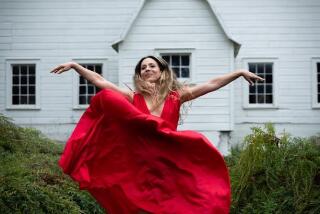POP MUSIC REVIEW : Ohio Players, Zapp: Funky Time vs. Party Time
- Share via
ANAHEIM — Wednesday night’s bill at the Celebrity Theatre told a taleof one city, one musical genre, and two radically different performing approaches.
The city in question was Dayton, Ohio, home of both Zapp and the Ohio Players. The style was funk. As for the contrasting approaches, just consider the band names.
The Ohio Players were players, above all else--straightforward funksters who churned out effective grooves and a couple of soulful ballads without commotion or extracurricular ado in their 50-minute opening set.
Zapp was a performing zoo, presenting a hyper collage of nonstop movement, musical pastiche, and shameless gimmickry. While leader Roger Troutman and his band of six backup carousers in glittery pajamas were musically adept, the playing wasn’t the thing, so much as the playing around.
Though they hail from the same city and play the same brand of music, the two bands come from different musical generations. The Ohio Players emerged in the early ‘70s, picking up where Sly & the Family Stone left off. Zapp appeared in 1980, with ‘70s funk star Bootsy Collins serving as its mentor.
There has to be a tremendous temptation for any ‘70s or early-’80s R&B; band to jump on the hip-hop bandwagon simply because rap-derived rhythms and sonic touches have become such a dominating commercial force, and so definitive of contemporary R&B; style.
But the Ohio Players managed to resist it. The audience at the Celebrity belonged to the hip-hop generation: It was overwhelmingly a teens and early-20s crowd, kids whose parents probably grew up listening to Ohio Players hits like “Funky Worm,” “Skin Tight” and “Fire.” Even so, these veterans--two of the five members, drummer Jimmy (Diamond) Williams and front man Leroy (Sugar) Bonner, remain from the ‘70s lineup--stuck with the basic funk approach from their past. Williams called out a couple of rap-style exhortations to “get busy.” Otherwise, the only hip-hop element was a brief allusion to Hammer’s “Too Legit to Quit” tossed into the middle of “Fire.”
Bonner’s voice was gargly and worn, but the rest of the band cushioned it with some sharp falsetto harmonies. That weathered, ragged quality turned into an asset on the soulful ballads “I Don’t Want to Be Alone” and “You’d Better Love Somebody.” The theme in both was the fear of loneliness, and Bonner’s lived-in voice brought it to life with plaintive urgency.
After a slow start, the Ohio Players showed that they could still make the funk sizzle on their finishing numbers, “Love Rollercoaster” and “Fire.” Those and several other songs drew a rise of recognition and brought part of the audience to its feet. Evidently, solid funk like the Ohio Players’ has a long shelf life.
It’s questionable whether most of the Zapp repertoire will meet a similar endurance test--most of the band’s material is nothing but disposable. But the point of its 70-minute set wasn’t to highlight super material, but to use snippets and bits of songs as grist for a nonstop party.
Roger (Zapp’s leader goes by his first name) had no reservations about appropriating some hip-hop trappings. His show incorporated rap dance moves, rap fashion and some out-and-out rapping. But Roger’s use of rap didn’t come off as the unseemly trend-jumping that it might be for another veteran of pre-hip-hop funk. That’s because Zapp appropriates just about everything it can grab off the library shelves of black music.
Rap became just one more source from which to quote in a show that copped everything from breezin’ George Benson jazz to B.B. King blues, from Stevie Wonder harmonica tooting to Sly Stone’s vocoder voice-distortions (90% of Roger’s singing was done through a device that let him control tone and pitch with a keyboard synthesizer, the result being a human-computer effect).
Zapp’s show was geared to the MTV generation’s attention span. It jumped herky-jerky from song snippet to song snippet.
Ultimately, Zapp’s unrelenting energy lifted the show above its gimmicks. Yes, just about every move was choreographed (the Rams’ offense should be so well-drilled), but Roger and company had a way of making it seem like orchestrated chaos instead of slick calculation.
Roger did pause long enough to deliver a fairly straightforward, uninterrupted rendition of “I Want to Be Your Man,” a winning pop-soul confection from 1987. In the end, all of Zapp’s musical and physical careening didn’t signify much of anything, but it did make for a heck of a dance party.



